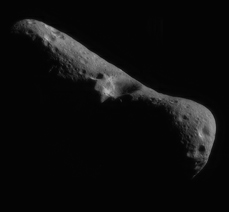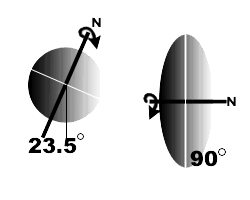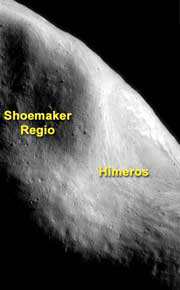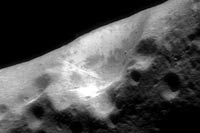
(126012935-126013483)
 |
| (126012935-126013483) |
Overall, Earth and Eros are very similar because they both have a tilted axis. The axis of both Earth and Eros are fixed in inertial space, meaning that as they move around the sun, the sunlight concentrates on different parts of the surface. The only difference between the two is that Eros is extreme in comparison with Earth. While Earth's axis is tilted at 23.5°, Eros' axis is tilted on it side at nearly 90° (Thomas et al. 2002; Veverka et al. 1999, 2000). Therefore, they both experience effects, but the effects on Eros are much more extreme.
 |
| Earth and Eros at summer solstice |
Another result of the extreme tilted axis on Eros is seasonal changes in lighting. As Eros orbits the sun, its axis stays fixed and, in doing so, the angle of the line that separates night and day, or terminator, changes. This is apparent in Flyover_14 and FeatureTrack_270b.
In addition to the axis the first looks at Eros also showed
its extreme shape. From the images that were acquired, the shape of the asteroid
was confirmed. The elongated shape (34 x 13 x 13 km) was made up of a convex
and a concave side. The convex side of the asteroid is dominated by the two
largest craters, Shoemaker and Himeros, and four semi-flat surfaces. The concave
side is more rounded and home to the third largest crater, Psyche (Veverka
et al. 2000, 2001; Thomas
2002; Prockter 2002). The shape of the
asteroid is well defined in the final approach images acquired on February 12,
2000.
The major process that forms topographic features on asteroids is impact cratering. The impact craters are formed from projectiles hitting the surface at hypervelocity. The impact forms a crater 20 to 50 times larger than the original projectile (Asphaug et al. 1996). Eros is a good example of this. On Eros, there are three large impact craters: Himeros , Shoemaker (not approved by IAU), and Psyche.
 |
Shoemaker Regio and Himeros (128510736-128511418) |
Superimposed on the southwest rim of Himeros is another large depression called Shoemaker. Like Himeros, Shoemaker's massive size (7.6 km), in comparison to the asteroid, gives the appearance of the crater walls failing. This crater also overlaps a part of Himeros. This crater is believed to be the youngest of the big three (Himeros, Psyche, and Shoemaker). The Shoemaker crater is home to 44% of boulders larger than 15 am across visible on the surface. It is also believed to be the source crater for many of the boulders that are on the surface. After the boulders on the surface were mapped, computer models were created to simulate the boulder ejecta layouts from different craters on the surface. Comparing the simulation to the map showed that it is most likely that Shoemaker was the source for many of the boulders on the surface. Since the boulders overlap other large craters and there is no indication of large amounts of boulders from either Psyche or Himeros, it can be accepted that Shoemaker is the youngest.
 |
| Psyche Crater (127684416-127685098) |